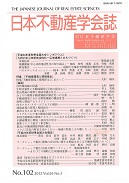26 巻, 3 号
選択された号の論文の24件中1~24を表示しています
- |<
- <
- 1
- >
- >|
-
2013 年 26 巻 3 号 p. 3-11
発行日: 2013/03/25
公開日: 2016/11/24
PDF形式でダウンロード (1402K) -
2013 年 26 巻 3 号 p. 12-13
発行日: 2013/03/25
公開日: 2016/11/24
PDF形式でダウンロード (401K) -
2013 年 26 巻 3 号 p. 14-27
発行日: 2013/03/25
公開日: 2016/11/24
PDF形式でダウンロード (1584K) -
2013 年 26 巻 3 号 p. 28
発行日: 2013/03/25
公開日: 2016/11/24
PDF形式でダウンロード (135K) -
2013 年 26 巻 3 号 p. 29-34
発行日: 2013/03/25
公開日: 2016/11/24
PDF形式でダウンロード (285K) -
2013 年 26 巻 3 号 p. 35-39
発行日: 2013/03/25
公開日: 2016/11/24
PDF形式でダウンロード (353K) -
2013 年 26 巻 3 号 p. 40-46
発行日: 2013/03/25
公開日: 2016/11/24
PDF形式でダウンロード (1828K) -
2013 年 26 巻 3 号 p. 47-51
発行日: 2013/03/25
公開日: 2016/11/24
PDF形式でダウンロード (328K) -
2013 年 26 巻 3 号 p. 52-57
発行日: 2013/03/25
公開日: 2016/11/24
PDF形式でダウンロード (303K) -
2013 年 26 巻 3 号 p. 58-64
発行日: 2013/03/25
公開日: 2016/11/24
PDF形式でダウンロード (311K) -
2013 年 26 巻 3 号 p. 65-70
発行日: 2013/03/25
公開日: 2016/11/24
PDF形式でダウンロード (1032K) -
2013 年 26 巻 3 号 p. 71-77
発行日: 2013/03/25
公開日: 2016/11/24
PDF形式でダウンロード (340K) -
2013 年 26 巻 3 号 p. 78-84
発行日: 2013/03/25
公開日: 2016/11/24
PDF形式でダウンロード (1426K) -
2013 年 26 巻 3 号 p. 85-92
発行日: 2013/03/25
公開日: 2016/11/24
PDF形式でダウンロード (4118K) -
2013 年 26 巻 3 号 p. 93-100
発行日: 2013/03/25
公開日: 2016/11/24
PDF形式でダウンロード (1516K) -
2013 年 26 巻 3 号 p. 101-105
発行日: 2013/03/25
公開日: 2016/11/24
PDF形式でダウンロード (360K) -
2013 年 26 巻 3 号 p. 106-107
発行日: 2013/03/25
公開日: 2016/11/24
PDF形式でダウンロード (807K) -
2013 年 26 巻 3 号 p. 108-109
発行日: 2013/03/25
公開日: 2016/11/24
PDF形式でダウンロード (171K) -
2013 年 26 巻 3 号 p. 110
発行日: 2013/03/25
公開日: 2016/11/24
PDF形式でダウンロード (250K) -
2013 年 26 巻 3 号 p. 118-123
発行日: 2013/03/25
公開日: 2016/11/24
PDF形式でダウンロード (273K) -
2013 年 26 巻 3 号 p. 124-129
発行日: 2013/03/25
公開日: 2016/11/24
PDF形式でダウンロード (309K) -
2013 年 26 巻 3 号 p. 130
発行日: 2013/03/25
公開日: 2016/11/24
PDF形式でダウンロード (151K) -
2013 年 26 巻 3 号 p. 131-133
発行日: 2013/03/25
公開日: 2016/11/24
PDF形式でダウンロード (992K) -
2013 年 26 巻 3 号 p. 134-
発行日: 2013/03/25
公開日: 2016/11/24
PDF形式でダウンロード (258K)
- |<
- <
- 1
- >
- >|
